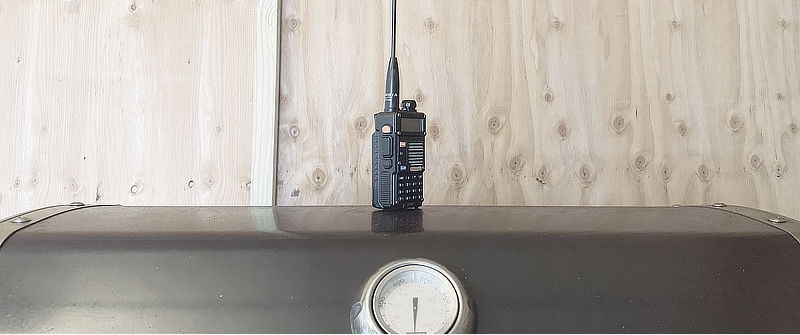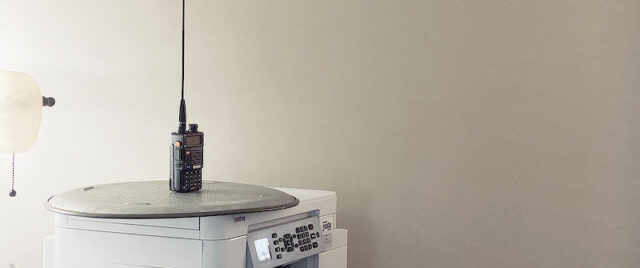Ground Plane for FRS/GMRS Radio Reception on HT Handhelds

A ground plane for your FRS/GMRS handheld transceiver. This tip really works quite well! It will greatly improve reception on your typical HT’s or handi-talkies for when you set it down simply for receiving (listening-monitoring). Though the method is not practical for transmitting, I will explain one work-around for this at the end.
I’ve known about it for quite a long time – thinking back to my days when I got my general-class ham license while learning about antennas (and the ‘ground plane’). However the notion doesn’t really come to mind while using a handheld radio transceiver, because there really isn’t a ground plane other than the body of the radio and/or your hand while holding it (keep reading).
Antenna Ground Plane
(geek alert section)
The antenna ground plane acts as a simulated ground. The only requirements to function as a ground plane is that it conducts, and the conducting surface must be at least a quarter of the wavelength of the radio waves in radius.
It’s a necessary part of a monopole (‘vertical’) antenna. A ground plane antenna is essentially one half of a dipole mounted vertically. In other words, in the case of a 1/4-wave antenna, the ground plane acts as the counterpoise to form, in essence, a centered 1/2-wave dipole.
When applying this to a handheld radio, you might say that the ground plane is the radio itself, your hand that’s holding it too. The dynamics are sort of ‘squishy’ in that the parameters (including SWR) are changing depending on how you’re holding it, etc.. It’s ordinarily not a concern when it comes to HT’s, because they’re not really meant for long distance communications. The best thing you can do in this regard is gain altitude! The higher the better. But lets get back to my ground plane tip..
What you can do for a FRS/GMRS handheld radio antenna ground plane
I know that lots of people have FRS/GMRS handheld radios – with it’s typical vertical antenna. I would say their primary use is while on-the-go. Communications between two people, or a group. Maybe hiking. Camping. Traveling. Off-roading. Security comms. Perhaps used at work. There are LOTS of use-case scenarios.
Sometimes however, you might simply set the radio down, and listen – in the background so to speak. Maybe at your camp. Or simply while at home. Here’s one scenario that I do quite often, and how it dawned on me about the ground plane improvement for receiving..
Before offering my simple and very effective tip, let me indulge with the story.
I have a BBQ-grill station out the back door under part of my 2nd-floor deck. It’s covered and mostly walled-in, with one side mostly open so ‘grillin’ smoke gets out. I can use it rain or shine, and through the winter. Anyway, I digress..
I grill a lot, so, when I’m out there, I bring my Baofeng HT. Mrs. J has one upstairs, and if she needs me, she’ll call me on a GMRS frequency of our choosing. Plus, I have my own radio set up to simultaneously listen to our regional Fire/EMS on a VHF frequency, just for fun – while I also use this time to listen in on one of my recorded podcasts with my earbuds in (multitasking).
One early evening while stepping into the grill station, it clicked (dawned on me) to set the radio on top of the grill cover. I don’t usually fire it up until my podcast is nearing its end (it’s my ‘me’ time while ‘chillin’ out there). Normally I set the radio on one of the horizontal framing 2×4’s. I thought to myself, “That big metal grill cover should act as a ground plane, and should improve reception a good bit..”
And wow – did it ever! Upon hearing a transmission, I would pick up the radio and move it away from the ground plane. The difference in reception was quite apparent between being on, or off, the ground plane. Nowadays I always set it there – until I fire up the grill!
Enough already – “Hey Ken, what’s the tip?”
Simple Ground Plane For Handheld Radio Reception
This Ground Plane Works For UHF and VHF Improved Reception
A Pizza Pan!

(Image: my Baofeng setting on a pizza pan on my office printer while I’m working)
That’s right, an ordinary pizza pan used as a ground plane. And the pizza pan just so happens to be big enough to exceed a minimum recommended ground plane radial dimension of 1/4 wavelength from the center (for FRS/GMRS frequencies).
The FRS/GMRS frequencies (channels) are up in the UHF band, right around 462/467 MHz. 1/4 wavelength is right around 6 inches. 1/2 wavelength is just about 13 inches. The pizza pan I happen to be using is 16 inches. So, perfect!
With that said, this also greatly improves reception while listening in on VHF too – even though those wavelengths are bigger.
Here’s an online (wavelength vs. frequency) calculator that’s useful.
Earlier I mentioned how I monitor a regional VHF frequency, which happens to be 154.445 MHz. It’s 1/4 wavelength is ~ 19 inches and it’s 1/2wavelength ~ 38 inches. However that 16 inch pizza pan still makes a huge difference in reception even though it’s smaller than optimum for VHF!
In the beginning I said that this FRS/GMRS ground plane tip is for improving reception of a handheld transceiver. This requires that you place the HT on the pan. Well what about transmitting? Is there a way to transmit without picking up the radio (which would negate that advantage)?
I suppose that you could use this setup for a sort of poor man’s mini base station. It would require that your radio accept some sort of external wired microphone. I have several Baofeng radios. They (and other brands) accept external microphones. So it could be done..
The trick though is the radio might tip over when using this way with the mic cable – without some creative support for the radio. Anyway, this tip is primarily for ordinary reception with the radio just setting there.
I was genuinely surprised as to the improvement this ground plane ‘tip’ provides for reception. Hopefully it will help someone out there. Oh, and you might also use an ordinary cookie sheet, or whatever else that’s conductive material. Be creative.
[ Read: Antennas for Baofeng Radios ]
